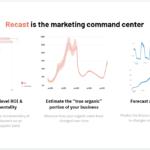MMM is about Causation not just Correlation
At the highest level, the idea behind MMM is to look at the correlation between marketing activity on one side and business results (revenue, new customers, leads, etc.) on the other. However, we don’t just want correlation. We want to actually estimate causation, so we want to be thoughtful about the statistical model we’re using so that we don’t pick up spurious correlations and attribute them to causation (also known as “incrementality”).
At a high level, you can think of all MMMs as a type of “regression” analysis. The idea behind a regression is to find a simplified model that best fits the data that has the property of yielding interpretable results like “when I spend an additional $10,000 on TV, I generate x number of incremental new customers”.
The word “regression” is unfortunately a bit overloaded since most people associate that term only with the methods they learned in their undergraduate statistics classes: a type of model known as a “simple linear regression”. While simple linear regressions are quite powerful for simple use cases, they unfortunately fall short of capturing the complexity needed to build a good model of marketing performance. For example, a simple linear regression has no way of dealing with:
- how seasonality impacts marketing performance
- how marketing performance changes over time
- diminishing marginal returns of marketing performance
- time-shifts or “adstocking” of marketing performance
- correlation of marketing spend
- and many other things!
So while at the very highest level Recast uses a regression methodology to yield the interpretable inferences we want, the underlying statistical model is much more complex than a simple linear regression model. To give a sense of scale: a simple linear regression can be estimated with just a few lines of code (like, less than 5) whereas Recast’s statistical model is made up of thousands of lines of code in order to capture all of the complexity in the world of marketing.
Recast Runs Simulations Based on the Laws of Marketing

Recast works functionally by building a simulated world (in code) that has all of these features and then running millions (and millions) of simulations to find the modeled results that best fit your data.
This is similar to how modern weather forecasting works: weather modelers build simulations of the physical world and then run millions of simulations to figure out what the most likely outcomes will be (will there be rain on your wedding day?). While weather forecasting algorithms use the laws of physics in their code, Recast uses the laws of marketing.
When Recast is fitting a model, it runs an astronomically large number of simulations to see which sets of results best fit the data. We validate the modeled results from the simulations by making predictions about the future and then confirming that those predictions come true on future data that the model has never seen before.
The major features of Recast’s model (the laws of marketing) are:
- Marketing performance in a given channel may change smoothly over time
- The “organic” part of a business may also change smoothly over time
- Marketing performance may be seasonable
- Marketing impacts are spread out in time beyond the time period when the marketing activity happened
- Marketing activity experiences diminishing marginal returns
- “Demand capture” channels like branded search are driven by other demand-generation channels
- Pricing spikes or holidays can have pull-forward and pull-backward effects
There are a large number of other smaller features but those are the major ones.
Conclusion
Overall, while Recast is similar in spirit to a simple regression model, both the theory and the mechanics of how it gets to results are much more complex. A simple linear regression makes lots of assumptions that just don’t make sense in the world of marketing, so it’s critical to have a more sophisticated framework that can capture all of the real-world complexities that affect how marketing works.



